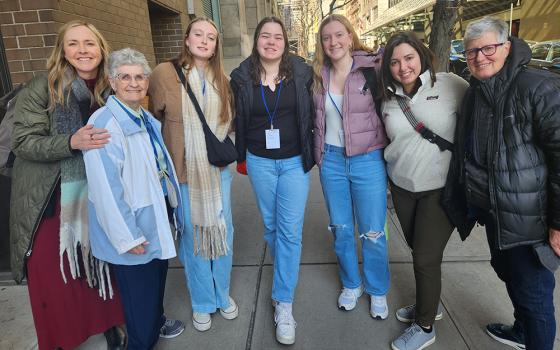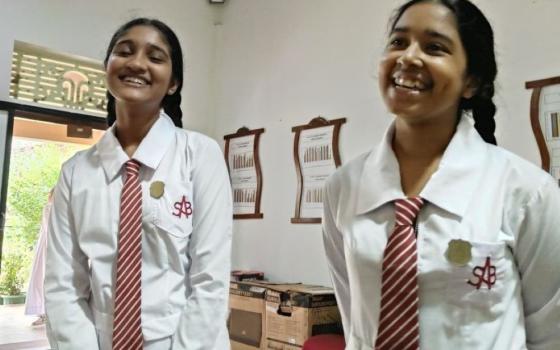
In the taxi taking my wife and me to the airport in San José, Costa Rica, I noticed a magnetized icon on the dashboard. It turned out to be La Negrita, the local nickname for the beloved Virgin Mary. If it had been Argentina, she would have been named the Virgin of Lujan, that country’s patron saint; if Mexico, Our Lady of Guadalupe, “Patroness of the Americas.”
Shrines to Mary are found all over the globe.
There are no shrines to God the Father, unless you count churches as shrines. Why do Catholics love Mary so much more than they love God? They know they’re not supposed to. They just can’t help themselves.
The reason seems actually fairly obvious. We humans find it difficult to love what we cannot see or even imagine. God the Father is unimaginable. So Catholics, while granting God first place in their minds, give their hearts to his concrete creations: beings with faces, histories and experiences we can identify with. It’s not logical to do this, but since when were humans logical?
Of course, better educated Catholics try to be logical. Many of them wouldn’t be caught dead praying to a saint, including the Virgin. They left this practice to the world’s peasantry years ago. With their enlightened -- or should I say Protestant? -- theologies, they address only the boss, or maybe the boss’ son. But never a footman or domestic like a saint.
Of course, Catholics like this could be mystics, and mystics strive for something deeper than intercessory prayer. I respect those who plumb the depths at the heart’s deepest point in a search for God. I work on this kind of “centering prayer” myself. But not all the time, not even most of the time.
More often I pray to -- well, the dead. And not even the canonized dead like Mary or St Francis. I have a steady date with my family’s guardian spirits (or angels if you prefer), whom ever they may be. I believe they are vitally concerned with me and my family and just might be able to help us when we can’t help ourselves. Not by working miracles, of course, but by shoring us up in subtle, intangible ways when life begins to wear us down.
You might wonder why I, an intellectual schooled in logical thinking, don’t pray exclusively to God, the acknowledged source of all. Well, God, to me, is so stupendous a being that most of the time I’d rather not subject him/her to my little dilemmas. I turn to God when I’m in serious trouble -- and that isn’t often.
The Catholic church wisely understands and even applauds the humility underlying prayers to saints. She has certified that there are thousands of former earthlings empowered by God to help us and waiting to hear from us. She has named them and even specified their expertise. Meanwhile Protestant Christians and orthodox Muslims look at this “quaint” practice and either deplore it or chuckle at it.
I once did, too. But my study of world religions slowly converted me. I found that most of the world’s prayers throughout its history, right up to the present day, have been addressed to beings far less divine than the master of the universe. Hindus have their minor gods and goddesses, Buddhists their bodhisattvas, and Muslims their pirs. The Chinese, Japanese and Koreans, since the beginning of their recorded histories, have prayed to their ancestors. Many sub-Saharan Africans with their ancestor cults address God only in exceptional conditions of crisis threatening the entire tribe, even after the tribe has formally converted to Christianity or Islam. And Catholics have their saints.
But do ex-humans really have the power we hope they have? True, the church says that some do. But do they really? How do we know? How does the church know? The church puts every would-be saint on trial to see if witnesses can prove the saint’s credentials, and usually the saint prevails. But let’s face it: This is not an exact science.
On the other hand, neither is the theology that claims God answers our prayers. So why not take our choice?
So I decorate my private home altar with fresh-picked flowers and light a candle. At the center of the altar is a beautiful picture of a saint meditating with light flowing down onto him from a divine source above and out of sight. My senses are engaged. I settle in. I begin to pray. I forget my senses. But it was my senses that got me started, that helped me focus.
The only question remaining for me is who the real power behind all these images is. Pope John Paul II credited Our Lady of Fatima, a Marian apparition, with saving his life from his would-be assassin’s bullet. Do the prayers offered to Mary actually get answered by Mary? Keep in mind that she must receive 500 million requests a day, and she, after all, is far short of divine. Do the prayers I offer to Mary or to some other canonized saint actually get answered by that saint, or are they intercepted by a spirit closer to me, more like me, an unknown saint whose task it is to help me and no one else?
Or is it the other way round? Does all prayer get answered by God, his saints being merely the lenses through which we look when we pray?
I don’t really know, and by now it doesn’t really much matter. What my faith and my experience tell me is that there is a tremendous reservoir of spiritual power that we, with help from somewhere, can tap into. And if an icon of La Negrita or a picture of Guadalupe or a sculpture of the Black Madonna of Czestochowa help me settle in, then I am foolish to decline the help.
I love Catholicism for its celebration of the concrete. True religion thrives when the human heart is engaged in a love affair with the divine. It is hard for the human heart to love an abstraction. So let us ignore the well-meant warnings from our Muslim brothers and sisters to pray only to the unimaginable God. Or the equally well-meant warnings from our Protestant brothers and sisters to desist from praying to saints, especially Mary, in front of statues in our churches. To remove the concrete from religion is to impoverish and disenchant it.
It is to hand over to the mind what belongs first and foremost to the heart.
Stafford Betty is professor of religious studies at California State University, Bakersfield.


